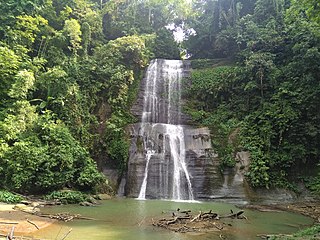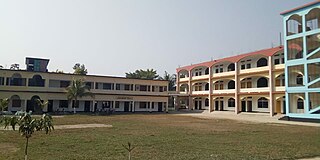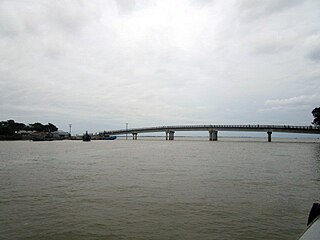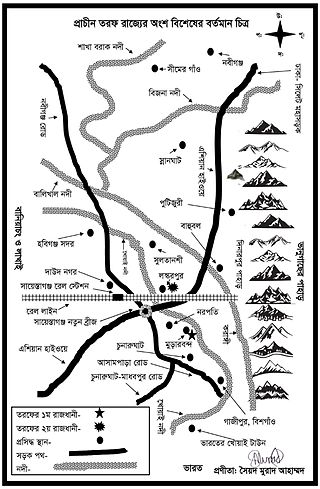
Isa Khan was the leader of the 16th-century Baro-Bhuiyan chieftains of Bengal. During his reign, he successfully unified the chieftains of Bengal and resisted the Mughal invasion of Bengal. It was only after his death that the region fell totally under Mughal control. He remains an iconic figure throughout West Bengal and Bangladesh as a symbol of his rebellious spirit and unity.

Moulvibazar, also spelled Moulabhibazar,Maulvibazar, Moulavibazar, and Maulavibazar, is the southeastern district of Sylhet Division in northeastern Bangladesh, named after the town of Moulvibazar. It is bordered by the Indian states of Tripura and Assam to the south and east, respectively; by the Bangladeshi districts of Habiganj to the west and Sylhet to the north.

The Nawab of Dhaka, originally spelt in English Nawab of Dacca, was the title of the head of one of the largest Muslim zamindar in British Bengal and Assam, based in present-day Dhaka, Bangladesh. The title of nawab, similar to the British peerage, was conferred upon the head of the family by Queen Victoria as a recognition of the first Nawab's loyalty and contribution to the social welfare activities.

Kamalganj is an upazila of the Moulvibazar District in the Division of Sylhet, Bangladesh.

Kulaura, is the biggest upazila (subdistrict) of the Moulvibazar District in north-eastern Bangladesh. The total area of this upazila is 545 km2. Hakaluki Haor, the largest marsh wetland in Sylhet Division and one of the largest in Bangladesh is partially located there.

Dharmapasha (Bengali: ধর্মপাশা, romanized: Dhormopasha, also spelled as Dharampasha or Dharamapasha, is an upazila of Sunamganj District in the Division of Sylhet, Bangladesh.

Beanibazar is an upazila (sub-district) of Sylhet District in northeastern Bangladesh, part of the Sylhet Division. The area is the successor of the territory of Panchakhanda, formerly ruled by the aristocratic Pal family.

Bishwanath is an upazila of Sylhet District in the Division of Sylhet, Bangladesh.

Khaliajuri is an upazila (sub-district) of the Netrokona District in Bangladesh, part of the Mymensingh Division.
The Conquest of Sylhet predominantly refers to an Islamic conquest of Srihatta led by Sikandar Khan Ghazi, the military general of Sultan Shamsuddin Firoz Shah of the Lakhnauti Sultanate, against the Hindu king Gour Govinda. The conquest was aided by a Muslim saint known as Shah Jalal, who later ordered his disciples to scatter throughout eastern Bengal and propagate the religion of Islam. The Conquest of Sylhet may also include other minor incidents taking place after Govinda's defeat, such as the capture of nearby Taraf.

The Greater Sylhet region predominantly included the Sylhet Division in Bangladesh, and Karimganj district in Assam, India. The history of the Sylhet region begins with the existence of expanded commercial centres in the area that is now Sylhet City. Historically known as Srihatta and Shilhatta, it was ruled by the Buddhist and Hindu kingdoms of Harikela and Kamarupa before passing to the control of the Chandra, Sena and Deva dynasties in the early medieval period. After the fall of these Buddhist and Hindu principalities, the region became home to many more independent petty kingdoms such as Jaintia, Gour, Laur, and later Taraf, Pratapgarh, Jagannathpur, Chandrapur and Ita. After the Conquest of Sylhet in the 14th century, the region was absorbed into Shamsuddin Firoz Shah's independent principality based in Lakhnauti, Western Bengal. It was then successively ruled by the Muslim sultanates of Delhi and the Bengal Sultanate before collapsing into Muslim petty kingdoms, mostly ruled by Afghan chieftains, after the fall of the Karrani dynasty in 1576. Described as Bengal's Wild East, the Mughals struggled in defeating the chieftains of Sylhet. After the defeat of Khwaja Usman, their most formidable opponent, the area finally came under Mughal rule in 1612. Sylhet emerged as the Mughals' most significant imperial outpost in the east and its importance remained as such throughout the seventeenth century. After the Mughals, the British Empire ruled the region for over 180 years until the independence of Pakistan and India. There was a complete list of the different amils who governed Sylhet which was recorded in the office of the Qanungoh of Sylhet. However, most complete copies have been lost or destroyed. Dates from letters and seal traces show evidence that the amils were constantly changed. In 1947, when a referendum was held, Sylhet decided to join the Pakistani province of East Bengal. However, when the Radcliffe Line was drawn up, Karimganj district of Barak Valley was given to India by the commission after being pleaded by Abdul Matlib Mazumdar's delegation. Throughout the history of Sylhet, raids and invasions were also common from neighbouring kingdoms as well as tribes such as the Khasis and Kukis.
Mansurnagar Union is a Union Parishad under Rajnagar Upazila of Moulvibazar District in the division of Sylhet, Bangladesh. It has an area of 15 square kilometres and a population of 37,323.
Khawāja Uthmān Khān Lōhānī, popularly known as Khwaja Usman, was a Pashtun chieftain and warrior based in northeastern Bengal. As one of the Baro-Bhuyans, he was a zamindar ruling over the northern parts of Bengal including Greater Mymensingh and later in South Sylhet. He was a formidable opponent to Man Singh I and the Mughal Empire, and was the last of the Afghan chieftains and rulers in Bengal. His defeat led to the surrender of all the remaining Pashtuns as well as the incorporation of the Sylhet region into the Bengal Subah. He is described as the most romantic figure in the history of Bengal. His biography can be found in the Baharistan-i-Ghaibi, Tuzk-e-Jahangiri as well as the Akbarnama.
Govinda Fenchu, better known by his regnal title Gour Govind and also known by the sobriquet Shomudro Tonoy, was the 21st and final king of medieval Sylhet's Gour Kingdom. He is described as a very conservative Hindu ruler whose reign started in 1260.
Gangadhwaj Govardhan was the 20th king of medieval Sylhet's Gour Kingdom.
The Pal family are a Bengali aristocratic family who historically held lands in what is now Sylhet, Bangladesh.

Taraf, previously known as Tungachal, was a feudal territory of the Sylhet region in Bengal and was under many petty kingdoms in different periods of time. It was part of what is present-day Habiganj District in Bangladesh.
Bayazid of Sylhet, also called Bayazid Karrani II, was a ruler in Sylhet during the early 17th century, in what is present-day Bangladesh. A prominent member of the Baro-Bhuiyan, Bayazid led military opposition against the Mughal Empire's expansion into eastern Bengal. His surrender following a sanguineous battle in 1612 ultimately resulted in their annexation of Sylhet.
Baghprachanda Khan is a village and mouza under Lauta Union, Beanibazar Upazila of Sylhet District, Bangladesh.











